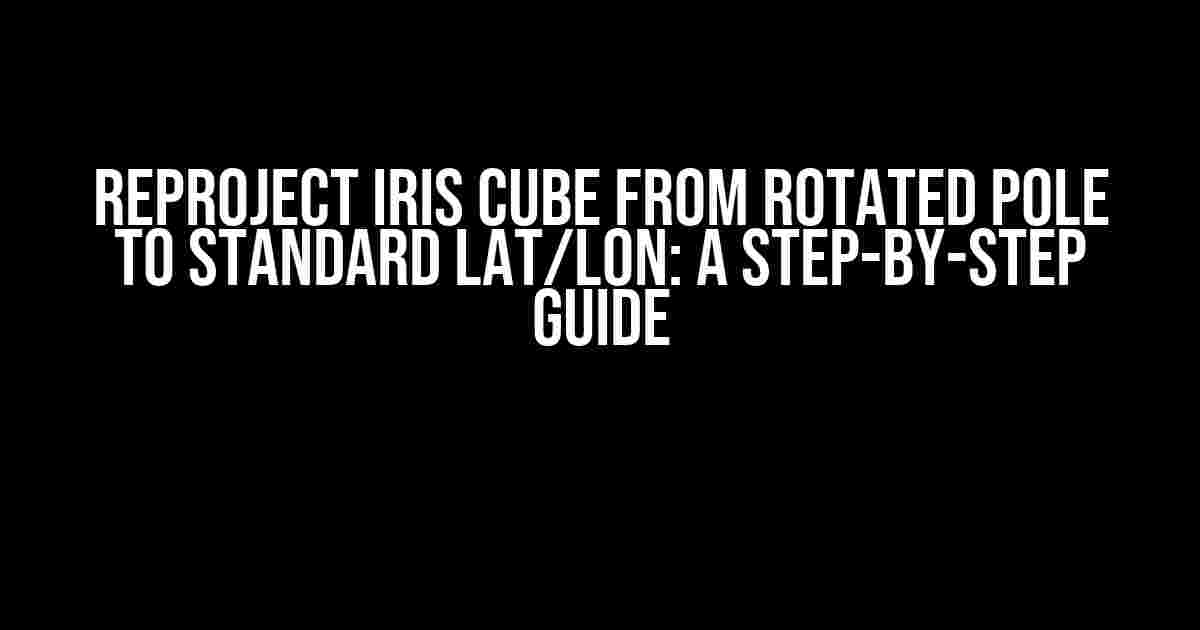Are you struggling to reproject your iris cube from a rotated pole to a standard lat/lon grid? Look no further! In this comprehensive guide, we’ll walk you through the process, explaining each step in detail and providing clear instructions to help you achieve your goal.
What is a Rotated Pole Grid?
A rotated pole grid is a type of grid projection used in geospatial data analysis, where the pole of the Earth is rotated to a different location. This is often done to simplify complex calculations or to align the grid with specific features or phenomena. However, when working with iris cubes, which are used to store and manipulate multidimensional arrays of data, it can be challenging to reproject the data from a rotated pole grid to a standard lat/lon grid.
Why Do We Need to Reproject?
There are several reasons why reprojecting your iris cube from a rotated pole to a standard lat/lon grid is necessary:
- Data Compatibility: Many geospatial tools and software assume a standard lat/lon grid, making it difficult to work with data in a rotated pole grid.
- Data Visualization: Standard lat/lon grids allow for easier visualization and interpretation of data, making it simpler to identify patterns and trends.
- Data Integration: Reprojecting your data enables seamless integration with other datasets and models, ensuring consistency and accuracy.
Prerequisites
Before we dive into the reprojecting process, make sure you have the following:
- Python installed on your system, along with the necessary libraries (numpy, iris, and cartopy)
- Iris cube in a rotated pole grid format
- Knowledge of basic Python programming and iris functionality
Step 1: Import Libraries and Load Data
import numpy as np
import iris
import cartopy.crs as ccrs
# Load iris cube
cube = iris.load('your_cube.nc', 'your_variable')`Replace ‘your_cube.nc’ and ‘your_variable’ with the actual file path and variable name of your iris cube.
Step 2: Extract Coordinate Information
# Extract coordinate information
lat = cube.coord('latitude').points
lon = cube.coord('longitude').points
gridlon, gridlat = np.meshgrid(lon, lat)
# Convert rotated pole coordinates to standard lat/lon
rotated_pole = cube.coord('grid_mapping_name').points
rotated_pole_angle = np.deg2rad(rotated_pole)This step extracts the coordinate information from your iris cube and converts the rotated pole coordinates to standard lat/lon.
Step 3: Define the Target CRS
# Define the target CRS (WGS84 lat/lon)
target_crs = ccrs.PlateCarree()This step defines the target CRS as the WGS84 lat/lon grid, which is the standard reference system for global navigation.
Step 4: Reproject the Cube
# Reproject the cube using Cartopy
reprojected_cube, _ = iris.analysis.cartography.reproject(cube, target_crs, output_coords='xy')This step reprojects the iris cube from the rotated pole grid to the standard lat/lon grid using Cartopy’s reproject function.
Step 5: Visualize the Reprojected Cube
# Visualize the reprojected cube using Matplotlib
import matplotlib.pyplot as plt
plt.figure(figsize=(10, 10))
plt.pcolormesh(reprojected_cube.coord('longitude').points, reprojected_cube.coord('latitude').points, reprojected_cube.data, cmap='RdBu_r')
plt.colorbar()
plt.show()This step visualizes the reprojected cube using Matplotlib, providing a quick visual confirmation that the reprojecting process was successful.
Troubleshooting and Best Practices
Here are some common issues and best practices to keep in mind:
| Issue | Solution |
|---|---|
| Memory errors during reprojecting | Split the cube into smaller chunks and reproject each chunk separately |
| Inconsistent coordinate information | Verify the coordinate information in your iris cube and ensure it matches the target CRS |
| Distorted or incorrect reprojected data | Check the reprojecting parameters and ensure the correct target CRS is defined |
Bonus Tip: Handling Missing Values
If your iris cube contains missing values, you may need to handle them before reprojecting the data. You can do this by adding a mask to the cube:
masked_cube = np.ma.array(cube.data, mask=np.isnan(cube.data))This step creates a masked array, where missing values are replaced with a mask. You can then reproject the masked cube using the same steps outlined above.
Conclusion
Reprojecting an iris cube from a rotated pole to a standard lat/lon grid can be a challenging task, but with these step-by-step instructions, you should be able to achieve your goal. Remember to verify the coordinate information, handle missing values, and troubleshoot any issues that arise during the reprojecting process. By following these guidelines, you’ll be able to seamlessly integrate your iris cube with other datasets and models, ensuring consistency and accuracy in your geospatial analysis.
Happy projecting!
Frequently Asked Question
Got questions about reprojecting iris cube from rotated pole to standard lat/lon? We’ve got answers!
What is the purpose of reprojecting iris cube from rotated pole to standard lat/lon?
Reprojecting iris cube from rotated pole to standard lat/lon is necessary to convert the data from a rotated coordinate system to a more standard and widely used geographic coordinate system. This allows for easier comparison and integration with other datasets.
What tools are available to reproject iris cube from rotated pole to standard lat/lon?
There are several tools available to reproject iris cube from rotated pole to standard lat/lon, including GDAL, PROJ, and iris itself. Each tool has its own strengths and can be used depending on the specific requirements and constraints of the project.
What are the common issues encountered while reprojecting iris cube from rotated pole to standard lat/lon?
Some common issues encountered while reprojecting iris cube from rotated pole to standard lat/lon include handling of missing values, dealing with coordinate system transformations, and ensuring data integrity and accuracy.
How to handle missing values during reprojecting iris cube from rotated pole to standard lat/lon?
Missing values can be handled by using interpolation techniques, such as nearest-neighbor or bilinear interpolation, or by setting a specific fill value. It’s essential to carefully consider the implications of each approach on the resulting dataset.
What is the impact of reprojecting iris cube from rotated pole to standard lat/lon on data analysis and visualization?
Reprojecting iris cube from rotated pole to standard lat/lon can significantly impact data analysis and visualization. It allows for more accurate spatial analysis, enables comparison with other datasets, and provides a more intuitive and familiar coordinate system for visualizing and exploring the data.

